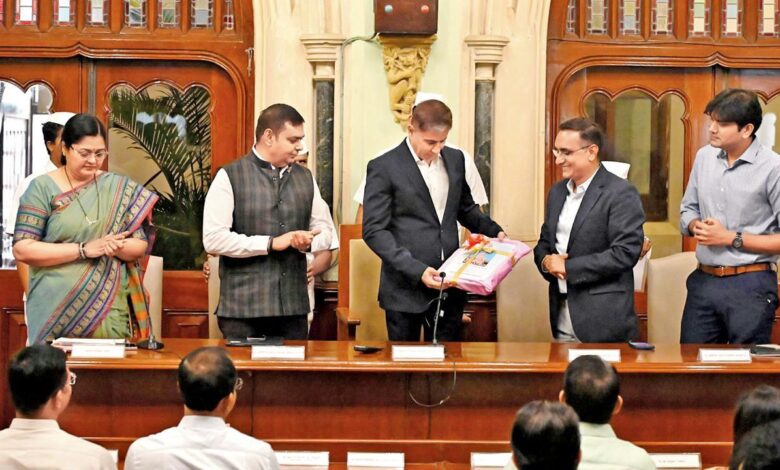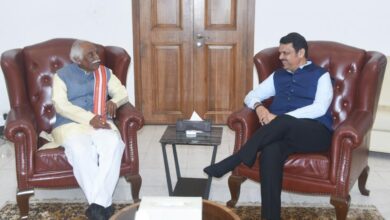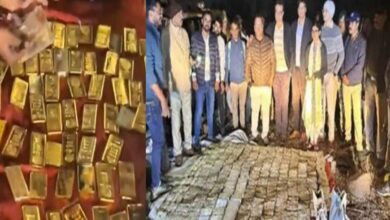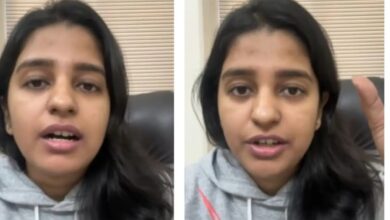Education receives larger share than last year but experts have mixed reactions

The BMC has unveiled an annual education budget of Rs 3955.64 crore for 2024-25. The civic body has augmented funds allocated for education by approximately R630 crore compared to last FY’s budget estimate of Rs 3321.55 crore.
The education budget builds upon the 2024-25 plan with greater investment in digital infrastructure, STEM education, student safety and health initiatives. While core projects like CBSE school expansion, CCTV security, digital classrooms and gamified learning continue, the introduction of financial literacy, robotics and cyber awareness programmes marks a significant leap in modernising municipal education.
Rajeshkumar Pandya, (right) teacher, Arundhati Chavan, president of PTA United Forum
Additional Municipal Commissioner (Eastern Suburbs) Dr Amit Saini presented the budget to BMC Commissioner and Administrator Bhushan Gagrani on Tuesday morning. According to the budget document in announcements for the education department, most of the initiatives and schemes mentioned have been carried forward from the previous year. The civic body has just listed changes and upgrades to be carried forward in 2025-26 with budgetary allocations.
A comparative analysis
The 2025-26 budget retains many provisions from the previous year while also introducing significant new initiatives to enhance infrastructure, modernise education and improve student well-being. Compared to the 2024-25 budget, the total allocation for primary education has increased from Rs 266.77 crore to Rs 300.71 crore. Digital classroom implementation remains steady with a budget of Rs 21.22 crore, reflecting a continued focus on tech-enabled learning. Efforts to support girl students have also been strengthened, with an increased allocation of Rs 19 lakh for sanitary napkins at the primary level, while secondary education remains funded at Rs 30 lakh.
Similarly, physical education has seen an increase in funding, rising from R40 lakh to R50 lakh for primary education, ensuring students continue to receive high-quality sports training and fitness opportunities. The expansion of CBSE, ICSE, IGCSE, and IB board schools continues, with four new CBSE schools added, mirroring the previous year’s approach. The modernisation of teaching methods remains a priority, with the ‘Gamified Learning App’ initiative now extending from Std X to include students of Std VII and IX.
Additionally, the reach of e-libraries has been expanded from secondary to 50 primary schools, enabling more students to access digital learning resources. In terms of infrastructure, the number of ongoing school repair and upgrade projects has increased significantly from 41 to 66, indicating a stronger push for improving educational facilities. The plan to establish astronomical laboratories, which was in its preliminary phase last year, has now moved into a pilot implementation stage.
The Mission Admission and Mission Merit programmes are being sustained with a renewed emphasis on literacy, numeracy and student preparedness for competitive exams. Similarly, investments in physical education remain robust, ensuring continuity in training and sports competitions. Overall, the 2025-26 education budget builds upon previous efforts while introducing key changes to enhance the quality of education in BMC schools.
‘Commendable efforts’
BMC Education Officer Rajesh Kankal said, “All of our demands have been met by this budget. We have tried to bridge all the gaps in the processes. The budget is made by considering all the factors for overall development under mission SAMPURN (School Infrastructure, Admission, Merit, Productivity, Universalisation, Responsibility, Nutrition and Health). We have also included all the components, including cyber literacy. This year, there have been more allocations as well. We have also proposed buying new chairs and tables for students which will prove beneficial.”
Mario Fishery, an educator, said, “I appreciate the BMC for its commendable efforts to elevate education through initiatives such as the launch of new CBSE schools, digital classroom upgrades, skill development centres and teacher recruitment. The introduction of STEM robotics, astronomical laboratories and English language labs demonstrates a forward-thinking approach aligned with the National Education Policy. The implementation of organic farming concepts in 100 schools is a noteworthy initiative that promotes environmental awareness and healthy living among students. The BMC must also actively showcase these schools as evidence of these achievements to inspire confidence and encourage public engagement.”
Highlighting certain areas which require further attention, Fishery added, “The pace of school infrastructure upgrades must be accelerated to ensure safe and modern learning spaces. Nutritious food and comprehensive sanitation facilities must be prioritised as fundamental components of student health and well-being. Equally important is the need to prioritise mental health support by establishing counselling services and mental health awareness programmes in schools to help students manage stress and develop emotional resilience.”
‘Uniforms?’
Rajeshkumar Pandya, a teacher, said, “A sharp eye should be kept on whether the requirements of the students are met. Many a time, uniforms and books do not reach the students for months. Several schools are facing a shortage of teachers. It is required to check what the actual requirements are rather than making schools look better externally.”
Arundhati Chavan, president of PTA United Forum, said, “I am very unhappy with this budget. Very few civic schools are well-maintained. About 75 per cent of the civic schools are in a very bad state and lack facilities. These schools have good teachers but little to no infrastructure. Also, the teachers’ training is another important aspect which was not given much importance in the budget. In many schools, NGOs are providing teachers for pre-primary education due to a shortage of teachers. Some schools are in a pathetic state. There is no mention of uniforms or books; rather, they have mentioned tablets. It isn’t mentioned how many students will actually get these devices or which ones will be given to them.”
Key allotments
>> STEM robotics labs (Rs 10 crore) – Advanced robotics and coding education
>> Cyber literacy (Rs 23.6 crore) – Digital safety awareness for students
>> Student assessment system (Rs 1.7 crore) – Regular evaluation mechanism
>> Supplementary nutrition scheme (Rs 117.37 crore) – Additional nutrition support beyond mid-day meals
>> English language labs (Rs 10 crore) – Enhancing spoken and written English skills
>> Jaadui Pitara (Knowledge Box) (Rs 10 lakh) – Interactive learning resources for primary students
>> Mission Financial Literacy (Rs 12 crore) – Introducing financial education in schools
Salient features of education budget
Continuation and expansion: Almost all major projects from 2024-25 have been retained and expanded
Increased budget allocation: A significant rise in capital expenditure (R411.30 crore) suggests more investment in infrastructure and new technology
New Innovations in learning: Cyber literacy, STEM robotics and financial literacy have been introduced for modern education needs
Pending state grants issue: Despite higher municipal funding,
the pending Rs 6,581.08 crore from the state government remains a challenge
Brand new initiatives
Mission SAMPURN: A new holistic initiative aimed at enhancing school infrastructure, increasing student enrolment and promoting merit-based education
Health and well-being focus: Autism therapy centres will be established
Expansion of digital learning: Gamified learning apps will be extended to more students, and additional e-libraries will be set up in primary schools
Infrastructure and security enhancements: CCTV cameras will be installed in suburban school buildings, and open gymnasiums will be introduced in 200 suburban BMC schools.
Organic farming (kitchen gardens) will expand in suburban schools, provisions for sanitary napkins and health checkups will see an increase
– With inputs from Prasun Choudhari
Source link





